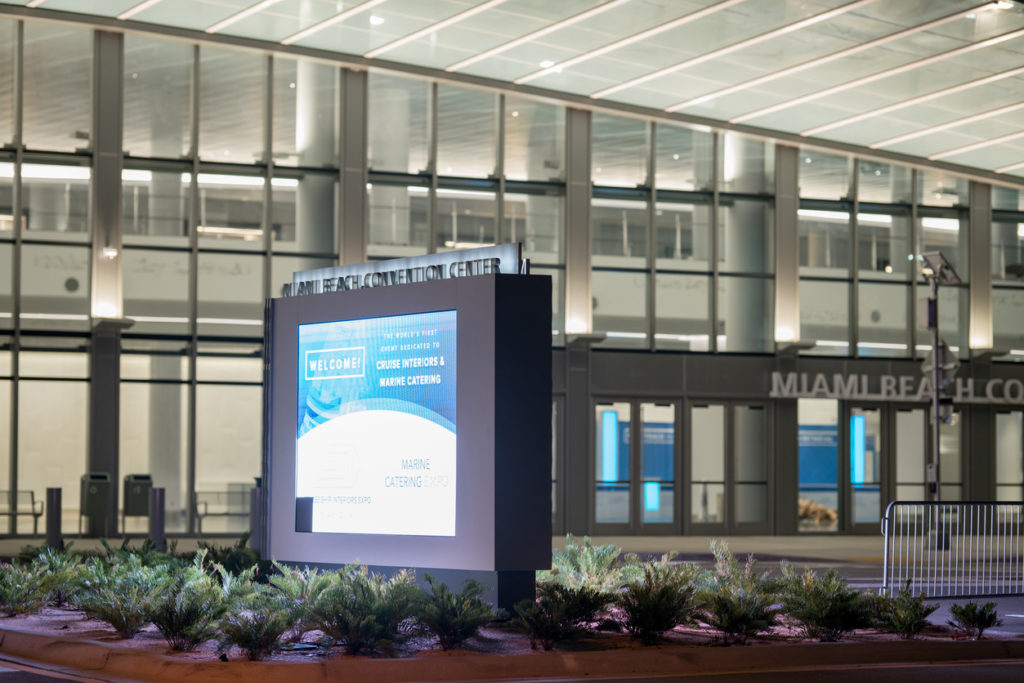What is digital signage?
Digital signage refers to the use of digital displays to showcase information such as images, videos or streaming media. Digital signage can be deployed indoors or outdoors, and may include consumer-directed advertisements, local area information, public transportation schedules or even quick service restaurant (QSR) menus. Digital signage can also be helpful when deployed as a static directory or map for shopping malls, transportation hubs, museums, hospitals, college campuses, corporate offices, hotels, or conference centers.
The advantage of digital signage over traditional displays is that information can be presented in a large enough format that multiple individuals are able to view it at the same time. It also allows for real time changes to be made so that the information shown is always up to date. This type of functionality can be invaluable in places such as hospitals, post offices and corporate buildings as it allows the business to run much more smoothly with fewer customer service agents.

What uses are there for digital signage?
So why is digital signage important? Digital signage helps to simplify and streamline the flow of information between entities such as businesses to an end customer. It allows a business to provide up to date information to the consumer while still running efficiently without additional manpower required, which helps to keep all parties informed. Below are 5 examples of their utility.
In hospitality, it proves invaluable with providing guests with the ability to check into their own rooms, or order their own food at quick service restaurants. With commercial businesses like malls, they provide an eye-catching way of displaying constantly-rotating advertisements, allowing a wide variety of businesses and services to be featured.
For organizations such as government agencies, hospitals, municipal transportation authorities, and DMVs, digital signage can provide up-to-date information on wait times for service, which decreases customer stress and agitation, therefore increasing their satisfaction.
Companies with many employees utilize digital signage to help employees navigate individual buildings as well as assisting them in locating a specific meeting room or employee’s office.
Lastly, for larger commercial venues such as museums and stadiums, digital signage can help customers or visitors to more easily find their way around the facility, while providing advertisements relevant to their interests.
Which industries use digital signage?
As stated previously, digital signage is invaluable across a number of different industries as they help facilitate the flow of information from business to consumer or end user. They are also an excellent way to increase incremental revenue via paid outside advertisement, as well as helping to build the company’s brand.
Here are some examples of how different industries utilize digital signage:
- Hospitality: Hotels and conference centers deploy digital signage to better communicate local area information to guests, including nearby restaurants, transportation options, traffic and weather, as well as to display advertisements.
- Food Service: Quick service restaurants (QSRs) employ digital signs as easily-readable large-format wall menus that can be changed on demand based on item availability and specific specials.
- Corporate Offices: Corporate offices employ digital signage to assist with wayfinding in and around their offices, including on large campuses. This can prove to be invaluable for getting meeting attendees to conference rooms on time, or allowing employees to find each others’ individual offices.
- Transportation Authorities: Public transportation utilizes digital signage to better aid travelers by providing real-time information about arrivals and departures, as well as travel times, which decreases potential frustration when there are delays. It is also used to display paid advertising, allowing municipalities to receive much-needed incremental revenue which, in turn, allows them to continue to upgrade their public services.
- Retail: Retail centers such as malls employ digital signage to help showcase sales and stores, display advertisements, and assist guests in navigating the area via maps and directories.

What is the cost of digital signage
The cost of digital signage varies greatly, but $1000-$3500 is average for small-to-medium displays, plus the cost of software and annual maintenance ($500-$1000 each). Very large digital displays, such as the ones you may see in airports, malls and QSRs, can run upwards of $10,000 depending on the desired features.
Types of digital signage
Digital signage appears in many forms that are readily accessible and easy to spot. Here are some common examples:
- Digital posters: Usually consist of a simple, static, non-touchscreen digital display placed flat against a wall, providing an attractive visual point of interest.
- Freestanding digital displays: Perhaps the most iconic, freestanding digital displays come in a wide variety of sizes and are very flexible. They are most commonly seen in shopping malls and other environments where there is very little wall space available.
- Ceiling-mounted displays: Most often found in airport terminal walkways in large formats to display advertisements or arrival and departure information, or in smaller versions in bus shelters. These can be less intrusive than other display form factors, but still provide pertinent information when needed.
- Outdoor digital signage: Rapidly replacing large billboards of the past, outdoor digital signage can display advertisements and other information in a weatherproof enclosure.
- Digital tablet displays: Useful in corporate offices and hotels, tablets can provide basic functionality such as area information, wayfinding and weather.
Why is digital signage important?
- Branding: Digital signage allows organizations to interact directly with their target audience, as well as displaying information about the brand, showcasing its desirability. This can help increase both brand and product-specific awareness.
- Convenience: With the widespread availability of digital signage, it is much easier for the average use to “help themselves.” Information can now be readily displayed, allowing the end user access to up-to-date information at any time.
- Cost savings: Digital displays that allow greater access to information also allow organizations to decrease overhead while increasing operational efficiency.
- Utility: Digital signage can accomplish many different tasks such as customer engagement, brand awareness, and advertising, and wayfinding.
- End user satisfaction: As its name implies, digital signage is digital, allowing all the information to be updated in real time, leading to more accurate information being disseminated, which ultimately benefits both the consumer and increases their satisfaction.
Some real life examples of companies utilizing digital signage today, we have a few examples. Between commercial and more utilitarian works, digital signage helps each of these companies with a different task.
What is the future of digital signage?
Because digital signage’s software is becoming almost entirely “cloud” based, it is expected to become even commonly deployed than it is today as organizations begin to fully comprehend the benefits of signage that can be easily and remotely updated to communicate the most up-to-date information to their end users. Digital signage benefits almost every industry, from retail and transportation, to hospitality and health care. Due to this flexibility across environments, digital signage will be a popular choice for many years to come.


